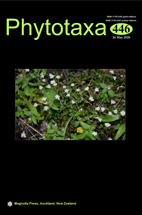Abstract
During a survey of the diversity of Mucorales in Atlantic Forest and upland rainforest soils in northeastern Brazil, two strains belonging to Absidia were isolated. These strains are morphologically and molecularly (nuc rDNA internal transcribed spacer ITS1–5.8–ITS2 and D1–D2 domains of nuc 28S rDNA) distinct from other Absidia species. Absidia cornuta sp. nov. presents exclusively cylindrical sporangiospores and up to three projections on columellae. Absidia pernambucoensis sp. nov. presents up to two apical projections on columellae and produces two types of sporangiospores: cylindrical and slightly cuneiform. Based on morphological and phylogenetic evidence, two new species of Absidia are proposed. An identification key for the species of Absidia with cylindrical sporangiospores found in the Neotropics is provided.

